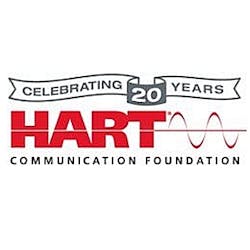Celebrating 20 years supporting the HART Protocol, the HART Communication Foundation gathered in Houston Thursday to discuss its history, some tips, and a few successes with HART device users, system integrators and suppliers.
When HART began back in 1993, it was a somewhat different show than it is today. Called the HART Users Group, it was a one-man show. “It was really just me,” said Ron Helson, executive director of the foundation. “It was a one-man office, for the most part.”
The foundation grew out of a 1990 meeting of industry professionals from 26 companies, marking the beginning of HART as an open communication standard. Now the organization has a full-time staff—with headquarters in Austin, Texas, and offices in Basel, Switzerland; Tokyo; and Shanghai, China). It has more than 280 member companies, and an installed base of close to 38 million.
HART communication builds on a traditional 4-20 mA signal, laying a digital signal over top of the analog. There are two basic principles behind the standard: backward compatibility and interoperability. “Everything we do is backward compatible,” Helson said. “We don’t want to obsolete products that are in the field.” HART also aims to keep everything easy to use in the plant, he added.
With that, HART accounts for nearly half of the communications links in its sector; 47.2% of the process measurement and control devices are HART devices. Looking to the future, Helson said, “We will continue to be strong; we will continue to be a leader.”
David Eisner, chief engineer and senior engineering fellow for Honeywell Process Solutions, pointed to ease of use, interoperability, extensive product selection, and easy integration of HART device data as key reasons to use the HART protocol in process communications. He also noted that it has the lowest installed cost among competing protocols, wiring is simple, no special power conditioning or diagnostic models are required, and it uses less equipment room cabinet space.
The skills required to deal with the HART standard are also minimal, Eisner said. “You usually can get access to staff that already has the basic technology training and know-how,” he said. “Because the tools are straightforward, if you’re installing systems in various parts of the world where skill levels are not up to speed, you can do it with HART.”
The HART Communication Foundation has been a steady source of innovation over its life, Eisner said, noting the moves from wired to wireless technology; analog to digital; simple to complex devices; DCS, PLC and safety to remote I/O; and more. “There’s a good roadmap into the future, and I think you can count on the HART Foundation to be an innovator in this space,” he said.
The foundation will continue to evolve the technology to make sure it serves the needs of industry, Helson said. The future is going to be bright,” he added. “This technology will be in wide use in the industry for the next 20 years and beyond.”

